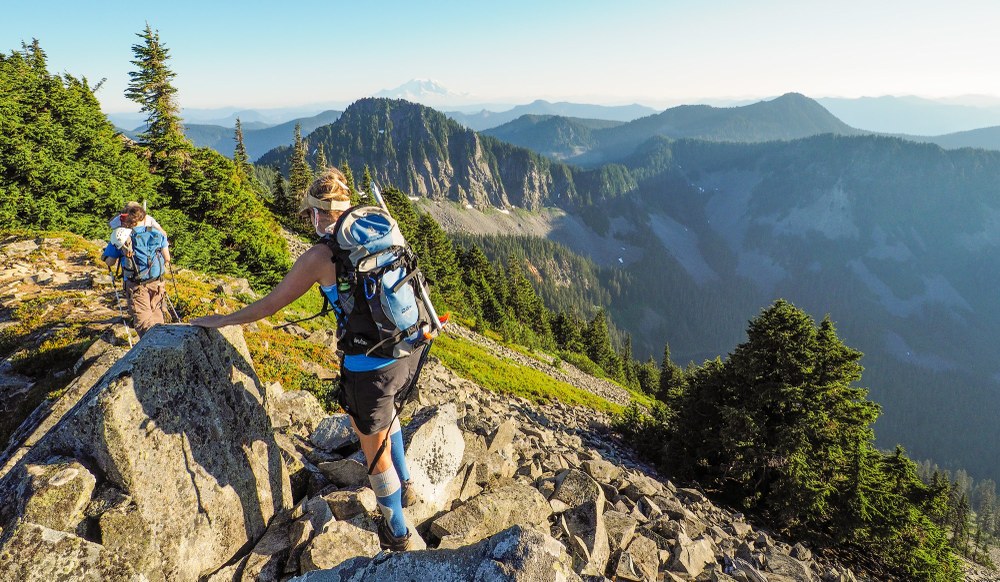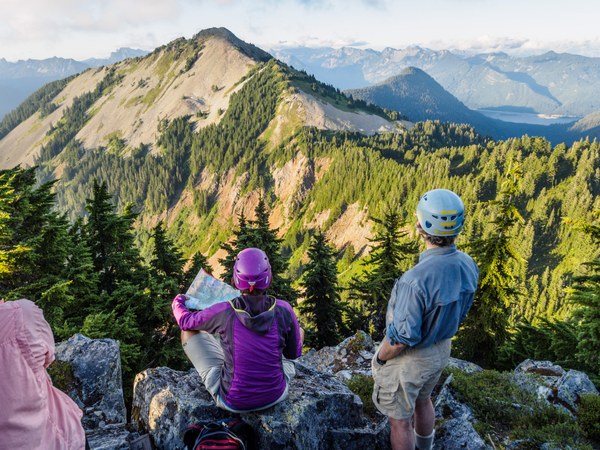
Unprepared adventurers, if they’re not lucky, can find themselves struggling out in the dark, under deteriorating conditions — or worse. Perhaps they leave without appropriate clothing or gear. Or they go without being cognizant of weather or available daylight. A few face difficulty because they chose an objective they were not physically ready for. And some expose themselves and others to risk because they decide to continue the climb even though objective information suggests they would be safer turning around or choosing another destination.
Being prepared is more than a cliché. It’s critical. This article presents a number of issues to consider as you prepare for your next outdoor adventure.
Give yourself enough time to prepare
Is this a day trip to a moderate local crag or a multi-day trip into the Pickets? When do you intend to go — soon or some time in the future? Many objectives are such that you can decide what to do during the week, grab your gear Friday night and go. Others may take months of preparation. Your objectives will undoubtedly consist of both short, spontaneous, outings and longer-term adventures. The point here is to be aware and give yourself whatever time you need to get ready.
Check current conditions
Look online for resources, like mountaineers trip reports, summitpost.org, cascadeclimbers.com, searches initiated by simply inserting the name of your objective into the search engine. Consider if this is an objective you want to commit the time and energy to in advance. Even if you are familiar with the objective, there may be barriers or other problems that have developed since you were last at your desired destination, such as trees blown down, altered river crossings, high or low snow conditions, changes to campsites, etc
Check meteorological and climatological information, including weather, snowpack, avalanche conditions, amount of daylight in the area you intend to explore. And be creative in identifying sources that may be helpful to you for your particular objective. For example, there may be automatic sensors giving snowpack information at certain ski areas that continue sending some information to NWAC even after the ski area has closed. And you might obtain information helpful to evaluating river crossings by accessing the USGS national water information system. The data from may not be for the exact location you‘re planning to visit, but could still provide a good sense of current conditions.
Research restrictions and regulations
What permits are required and when might each be available? What are the party size limitations? Will you need to reserve a campground? Where are campfires allowed? Look up the manager of the particular site and contact them if you can. Be aware if your objective requires access through private land. In some parts of the Cascades, private owners have developed their own permit systems for allowing access through their land. Start this process as early as you need to, given your destination. In addition, as you prepare, be sure to keep up to date with respect to any changes to permits or permitting that might take place from year to year or during a season. And don’t forget to check the expiration dates on whatever parking pass you will need to leave in your vehicle at the trailhead.
Understand the needs of individuals
Is your party experienced and fast? Experienced but slower? Inexperienced? Don’t rely entirely on someone else’s estimate of the time needed for the approach and climb — consider how much time you and your party may need. Are all members sufficiently adept at the necessary skills? Is there any further advance practice that would be helpful? What about compatibility? Any special needs? Is there a good range of skills so that each or at least most of the party members can contribute? One benefit of climbing with The Mountaineers is the ability to experience the outdoors in partnership with others, sharing responsibility, rather than as a client simply following a leader. Develop and follow a conditioning plan that will best enable you to meet the physical requirements you are going to face on your objective.
 Seattle Branch Alpine Scramble on Abiel Peak - August 6, 2015. Photo by David Bradley.
Seattle Branch Alpine Scramble on Abiel Peak - August 6, 2015. Photo by David Bradley.
Be aware of other parties
Having too many parties on a popular climb can mean your group may have to dodge objects knocked from above, or wait in line. Yet having others nearby can possibly add an element of safety, helping with care and communication in the event of a problem or even assisting in a crevasse rescue situation, for example. You cannot assume that others will detract from your experience; nor should you assume you can depend on others. Regardless, and to the extent you can do so, it is worth being cognizant of who else may be in the area.
Stay up-to-date with technology and gear
Don’t automatically resort to the “10 essentials” you’ve kept in your pack for years. Technology changes; things break; many first aid items lose their effectiveness; that box of your favorite bars may be a year out of date.
Take a fresh look to ensure your essentials are in the state of readiness you need. And that what you generally consider essential is appropriate for your particular objective. For example, if you usually obtain extra water by using tablets, check to confirm that this method is an adequate means of treating the water where you intend to go.
Be gear-specific and emergency-ready
Make sure you are systematic in preparing the climbing or other gear you need for your objective. If there is climbing gear you or members of your party don’t already own, be sure to identify that. Can you rent or borrow, rather than purchase it (be sure to inspect before departure, to ensure it is in working order). Assess the group gear you will need, and who will be responsible for what. Similarly, decide what duplicate items you want or need, in the event of loss or breakage.
Review club instructions and suggestions, including gathering all the contact information you need. And ensure you have a current copy of the Mountaineers Emergency Contact Procedures and Call Tree.
Allow for turnaround time
Having the best skill, information and gear to reach the summit only gets you halfway to your ultimate objective — returning home. And you could be in a difficult spot if you’ve left yourself with only one option. That’s especially true when you’re outdoors. The situation can change drastically in unforeseen ways — the weather changes for the worse; your group is slower than anticipated; you got off route and although you found your way, you expended more time than you wanted. That doesn’t mean you should avoid pushing yourself. By doing so, you gain strength and experience. But bear in mind the difference between pushing your limits and pushing them so much that you foreclose means of keeping yourself safe.
Identify the time needed given such issues as the speed of your party, the difficulty of descent, the length of daylight available and other external factors. Rappelling into darkness or scrambling over steep ledges under reduced visibility is not only scary but dangerous. And rushing to avoid darkness or other hazards increases the danger: when you are tired and under pressure it is that much more difficult to focus on the appropriate safety checks and procedures. So set your turnaround time. And plan on adhering to it. With few (although notable) exceptions, the mountain will still be there when you come back next time.
Have a back-up plan
There are plenty of reasons why your planned objective might not work out as planned. Perhaps the weather was not as predicted, there was too much or too little snow, your party was not fast enough on the approach, or a stream was too high to cross even early in the morning. If you have done some planning ahead, you may well be able to continue on an adventure, albeit a different one, rather than just turn around and go home. So, as you plan for your objective, consider if there are other alternatives in the vicinity. Be prepared with information about those alternatives and bring any additional equipment that may be needed. And include, in your emergency communication plan, your strategy for informing others of this change.
The point is to make sure you give yourself enough time to identify your needs with care and imagination, prepare methodically, and keep your options open.
This article originally appeared in our Summer 2016 issue of Mountaineer Magazine. To view the original article in magazine form and read more stories from our publication, click here.
 Helen Arntson
Helen Arntson